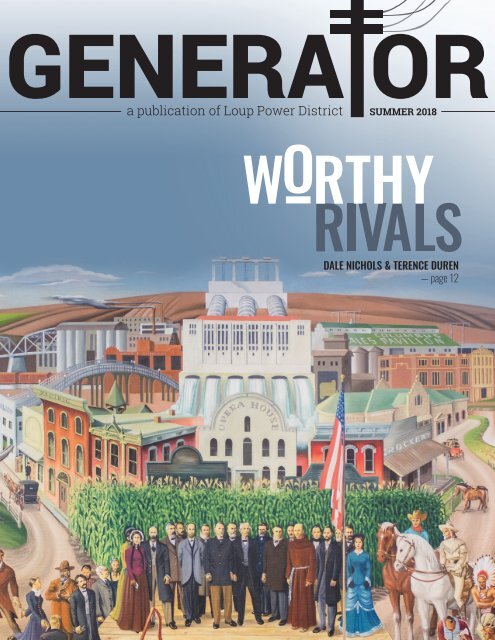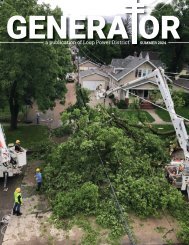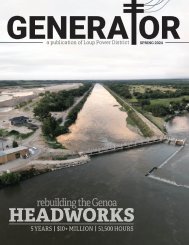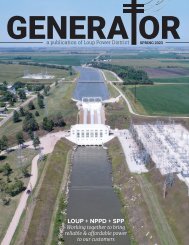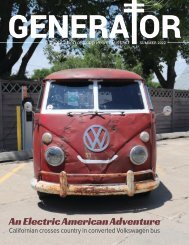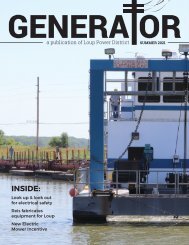Summer 2018 Generator
In the summer of 1945, a national artistic rivalry was building in rural Nebraska. Learn about the feud between artists Terence Duren and Dale Nichols in this issue. The magazine also gives an insight into the Genoa Indian School that once held almost 600 students.
In the summer of 1945, a national artistic rivalry was building in rural Nebraska. Learn about the feud between artists Terence Duren and Dale Nichols in this issue. The magazine also gives an insight into the Genoa Indian School that once held almost 600 students.
Create successful ePaper yourself
Turn your PDF publications into a flip-book with our unique Google optimized e-Paper software.
GENERA OR<br />
a publication of Loup Power District SUMMER <strong>2018</strong><br />
DALE NICHOLS & TERENCE DUREN<br />
— page 12
BOARD OF<br />
DIRECTORS<br />
SUMMER <strong>2018</strong><br />
Rich Aerni<br />
Chairman<br />
Larry Zach<br />
First Vice Chairman<br />
Francis Sand<br />
Second Vice Chairman<br />
Chris Langemeier<br />
Secretary<br />
Dick Tooley<br />
Treasurer<br />
Robert Cerv<br />
Jim Donoghue<br />
Alan Drozd<br />
Mike Fleming<br />
Ross Knott<br />
EXECUTIVE<br />
STAFF<br />
Neal Suess<br />
President/ CEO<br />
Walt Williams<br />
Vice President,<br />
Administrative<br />
Services/CFO<br />
David Bell<br />
Vice President,<br />
Development/<br />
Marketing<br />
Ron Ziola<br />
Vice President,<br />
Engineering<br />
Dan Hellbusch<br />
Vice President,<br />
Operations<br />
4 Genoa’s Indian School Museum<br />
preserves 50 years of history<br />
7 Electric vehicles growing in popularity<br />
8 Graduates and scholarship recipients<br />
10 Community Builders visits Humphrey<br />
12 Bone Creek Museum of Agrarian Art in David<br />
City hosting Duren/Nichols exhibit<br />
15 Loup installs Gridstream automated meters<br />
16 Community Builders visits Howells<br />
18 Employee Notes<br />
22 Around the District<br />
Loup Power District Service Area<br />
For more than 80 years,<br />
Loup Power District<br />
has provided reliable,<br />
low-cost electricity to<br />
our customers.<br />
The District also<br />
provides economic<br />
development and<br />
recreational services.<br />
The Loup <strong>Generator</strong> is<br />
published quarterly<br />
as a service for Loup<br />
employees, families,<br />
friends and associates.<br />
For feedback, story ideas and submissions:<br />
Stacy Wemhoff, Communications Coordinator | 402-562-57111 | swemhoff@loup.com<br />
2 GENERATOR
PRESIDENT'S MESSAGE<br />
New service center location has many benefits<br />
As many of you are aware, the District has<br />
started work on moving the current service<br />
center to a location between 18th Avenue and<br />
3rd Avenue, south of the Lost Creek Parkway.<br />
This location provides some strategic<br />
benefits and will allow the District to better<br />
serve all areas of the District operations in<br />
and around Columbus. It will also allow the<br />
District to combine our north storage yard<br />
(currently located in the industrial park west<br />
of Columbus Hydraulics) and the existing<br />
service center located along 12th Avenue.<br />
The District is doing this for several reasons.<br />
First and foremost, the City of Columbus<br />
needs area around the existing service<br />
center for the new 12th Avenue viaduct to be<br />
constructed in the upcoming years.<br />
After several discussions with the City, the<br />
District decided it was better for the District<br />
to move its entire service center to a new<br />
location, rather than try to coexist as the City<br />
constructs the viaduct. This was done for<br />
both a safety and an overall operations basis.<br />
The District purchased a parcel of land much<br />
greater than needed along the Lost Creek<br />
Parkway and we are working with others to<br />
develop this area in a way that most benefits<br />
the District and the Columbus region.<br />
Several developers have approached the<br />
District about locations in this new area<br />
(which has been named the Energy Triangle<br />
Addition) and the District is excited about the<br />
development possibilities for the area.<br />
Many people have asked if the District is also<br />
moving the General Office, which sits on 15th<br />
Street, to this location. This is not currently<br />
planned, as our existing General Office still<br />
meets the overall needs of the District. The<br />
District has enough space at the Lost Creek<br />
Parkway location, and will keep enough<br />
space in the future, in case a decision is made<br />
to locate the General Office in that same<br />
location along Lost Creek Parkway. However,<br />
that is not planned at this time.<br />
This location also is beneficial, as it is much<br />
closer to our hydro facility in Columbus and<br />
allows access to all parts of Columbus along<br />
Lost Creek Parkway.<br />
With the construction of the current viaducts<br />
in and around Columbus, serving all locations<br />
in Columbus will be accomplished in a more<br />
efficient fashion. In addition, the District will<br />
be able to serve other areas, such as Platte<br />
Center and some of our northern towns more<br />
efficiently.<br />
The District does not anticipate the need<br />
to increase rates associated with this<br />
construction, as cash reserves will be used to<br />
fund this new building. This was one of the<br />
key selling points to the Board of Directors<br />
that made this decision easier for all.<br />
We appreciate the public’s patience with the<br />
District as we move through this endeavor.<br />
We will provide more information as design<br />
and construction move forward.<br />
The Board of Directors and management<br />
are grateful for the discussions and general<br />
positive comments we have received<br />
regarding this decision. We look forward to<br />
continuing to serve all of our communities in<br />
the best possible way moving forward.<br />
by NEAL SUESS<br />
President/CEO<br />
SUMMER <strong>2018</strong> 3
Genoa’s Indian School<br />
Museum showcases<br />
50 years of history<br />
In 1884, the U.S. Indian Industrial School at<br />
Genoa welcomed its first 74 students by cutting<br />
their hair, giving them new uniforms and<br />
forcing them to give up their native language.<br />
Native American students attended the school<br />
for the next 50 years, reaching a peak of nearly<br />
600 students in 1932. It was one of the largest<br />
federal boarding schools in the country.<br />
The school began with one building on 320<br />
acres and grew to more than 30 buildings on<br />
640 acres.<br />
Many of the students went on to be successful<br />
with the skills they learned. But does that mean<br />
the school was a success? Many of the students<br />
and their families told another story.<br />
Top: The Genoa Indian School Museum today.<br />
Middle: U.S. Indian school students in their classroom.<br />
Bottom: The U.S. Indian Industrial School Band performs.<br />
Right: The school followed a strict, military model.<br />
Students wore uniforms and answered to roll call.<br />
4 GENERATOR
In 1857, the Pawnee Indians made<br />
a treaty with the U.S. Government to<br />
give up their their lands and resettle<br />
on a reservation in today’s Nance<br />
County.<br />
Less than 20 years later, the<br />
Pawnee signed another treaty and<br />
moved to a reservation in Oklahoma.<br />
The Office of Indian Affairs<br />
selected the former Pawnee<br />
reservation as the site for a new<br />
government boarding school.<br />
It was the fourth non-reservation<br />
boarding school in the country.<br />
Its mission was to assimilate the<br />
students into white society by<br />
teaching them basic education as well<br />
as vocations.<br />
Some of the children were taken<br />
from their homes and moved to the<br />
school. They came from more than<br />
40 tribes and may have ranged in age<br />
from 4 to 22.<br />
The school was run like the<br />
military. Students wore uniforms and<br />
marched. They answered to roll call<br />
and taps.<br />
Male students learned a variety<br />
of trades including harness making,<br />
tailoring, blacksmithing and farming.<br />
Females were taught nursing, sewing<br />
and baking.<br />
These jobs also helped bring in<br />
additional money. The school received<br />
only $167 per student per year for<br />
food, housing and clothing.<br />
They participated in<br />
extracurricular activities<br />
including athletics, band<br />
and choir. They also<br />
attended dances and<br />
other social activities.<br />
The school closed<br />
its doors in 1934<br />
as both the economy and philosophy<br />
of the time were changing. Students<br />
went back to their reservations,<br />
found alternate boarding schools or<br />
attended college.<br />
____<br />
Years after the school closed, some<br />
students started returning to visit<br />
Genoa. They also visited the Genoa<br />
Historical Museum in downtown<br />
Genoa.<br />
Museum volunteers and others<br />
from the community saw the need for<br />
a dedicated museum for the school<br />
and created the Genoa U.S. Indian<br />
School Foundation in 1990.<br />
The museum opened in the Manual<br />
Training Building that same year.<br />
Today, tribal flags hang<br />
throughout the building as a<br />
testament to the students who<br />
attended.<br />
The museum includes historical<br />
artifacts from the school, a scale<br />
model of the school’s campus and a<br />
replica of a school room.<br />
____<br />
Some of the the government’s<br />
pictures of the school feature<br />
students who seem to be happily<br />
engaged in learning.<br />
But museum volunteers Nancy<br />
Carlson and Alyce Tejral say many of<br />
these photos were propoganda pieces.<br />
Some students did look back on<br />
their time at the school favorably, but<br />
others told a different story.<br />
Students were punished for using<br />
their native language or trying to run<br />
away. At times, teachers struggled<br />
to quell the animosities between<br />
students of different tribes.<br />
The children struggled to adjust<br />
to the complete loss of their culture<br />
and their families. Many died<br />
because they were not immune to the<br />
tuberculosis and influenza that swept<br />
through the school.<br />
Carlson and Tejral said some<br />
former students didn’t talk about<br />
their time at the school because they<br />
didn’t want to remember.<br />
Now, it is the families who come<br />
back each year for the annual reunion<br />
or email the museum in hopes of<br />
learning more about what life was<br />
like for the students.<br />
Carlson said many family<br />
members walk around and absorb<br />
the atmosphere. Native elders and<br />
medicine men have visited the school<br />
to hold ceremonies for the spirits of<br />
the children who attended and those<br />
who lost their lives.<br />
Government officals and teachers<br />
may have been doing what they<br />
thought was right to help Native<br />
Americans succeed and adapt.<br />
And many did — going on to<br />
college and securing jobs. Some<br />
Native American parents even wanted<br />
their children to attend the Genoa<br />
school — especially during the tough<br />
times of the Great Depression.<br />
But time has shown that the<br />
trauma of losing family, culture and<br />
traditions caused more harm than<br />
good.<br />
“It was like a prison,” said student<br />
Michael Whitesnake in the NET film<br />
“White Man’s Way” in 1986.<br />
In the film, historian Ronald<br />
Naugle said that the experiment to<br />
assimilate Indians was a failure.<br />
“Indian values did survive. Their<br />
culture did survive inspite of our<br />
attempts to suppress it. But it was not<br />
without a cost,” Naugle said. “There<br />
was a great deal of personal pain and<br />
suffering and we’ll probably<br />
never know the extent<br />
of that.”<br />
SUMMER <strong>2018</strong> 5
Right: The walls of the Genoa Indian School<br />
museum still bear murals painted by the<br />
students who attended the school. The murals<br />
were used as patterns to create harnesses and<br />
bridles that were sold for the school.<br />
Below: Students make bridles and harnesses.<br />
Bottom: Students in their dorm room.<br />
LEARN MORE:<br />
• Sidney Byrd began attending the Genoa<br />
Indian School at age 6. He became a<br />
Presbyterian minister and was active in Dr.<br />
Martin Luther King’s civil rights movement in<br />
the 1960s.<br />
The Wo Lakota YouTube channel has several<br />
interviews with Byrd about his experiences<br />
at the Genoa School. ”No one to say<br />
goodnight or tuck you in,” he said. “Just four<br />
empty walls. You could hear the whimpering<br />
of the little boys lonely for their homes.”<br />
Watch: bit.ly/SidByrd<br />
PLAN YOUR VISIT:<br />
GENOA INDIAN SCHOOL MUSEUM<br />
402 Willard Ave, Genoa<br />
• White Man’s Way is a Nebraska Educational<br />
Television film from 1986. The film includes<br />
interviews with former students and<br />
historians.<br />
Watch: bit.ly/WhiteMansWay<br />
HOURS: Thursday through Monday from 1–5 p.m.<br />
from Memorial Day to Labor Day.<br />
ADMISSION: Free. Donations accepted.<br />
Also open throughout the year by appointment.<br />
Contact Alyce Tejral at 402 993-6036<br />
or Jerry and Nancy Carlson at 402-993-6055.<br />
6 GENERATOR
There are currently around 1,000 electric vehicles (EVs) on<br />
Nebraska’s roads today, with the market ready to expand.<br />
Electric vehicles are fun to drive and provide significant<br />
benefits to consumers and Nebraska’s economy.<br />
ELECTRIC VEHICLES KEEP MONEY<br />
IN THE POCKETS OF NEBRASKANS.<br />
Fuel efficiency is rated in kilowatt-hours (kWh) per 100 miles<br />
rather than miles per gallon. If you pay $0.11 per kWh for<br />
electricity and have an average electric vehicle rated at 34<br />
kWh per 100 miles, the cost is about $0.04 per mile. If gas is<br />
$3 per gallon and a gas-powered vehicle gets 25 mpg, the cost<br />
is about $0.12 per mile. This scenario amounts to a savings of<br />
$800 for every 10,000 miles you drive. Clearly, these savings<br />
can easily offset the additional cost to purchase an electric<br />
vehicle over the vehicle’s lifetime. The U.S. Energy Department<br />
has created a website to determine an eGallon, or the cost of<br />
fueling a vehicle with electricity compared to a similar vehicle<br />
that runs on gasoline.<br />
ELECTRIC VEHICLE MAINTENANCE COSTS ARE<br />
SIGNIFICANTLY LOWER.<br />
Plug-in electric vehicles typically have lower total cost of<br />
ownership and, in particular, lower maintenance costs. This is<br />
because they have fewer moving parts, reduced oil changes<br />
(or none for a full electric) and fewer brake jobs—battery<br />
regeneration absorbs most of the energy. Hybrids and plug-in<br />
electric vehicles can go 100,000 miles before receiving a brake<br />
job. Visit the Electric Power Research Institute for an electric<br />
vehicle cost of ownership report.<br />
ALL NEBRASKANS HAVE THE ABILITY TO CHARGE.<br />
Electric vehicles can be charged in the comfort of home,<br />
avoiding trips to the gas station. They can be charged on a<br />
standard 120V wall outlet, also called Level 1 charging. Faster<br />
charging can be achieved at home or workplace with Level 2<br />
charging.<br />
CHARGING STATIONS ARE CURRENTLY AVAILABLE<br />
ACROSS THE STATE.<br />
Public charging stations continue to pop up across Nebraska.<br />
Businesses, electric utilities, and government agencies<br />
are establishing a rapidly expanding network of charging<br />
infrastructure, proving it is possible to get nearly everywhere<br />
with an electric vehicle.<br />
ELECTRIC VEHICLES ARE SIGNIFICANTLY BETTER FOR<br />
THE LOCAL ECONOMY.<br />
EVs are fueled from energy from the local electrical grid, which<br />
is cheaper for all consumers. Money spent on local electricity<br />
gets reinvested back into the local economy.<br />
ELECTRIC VEHICLES ARE ENERGY EFFICIENT.<br />
Electric vehicles convert about 59%–62% of the electrical<br />
energy from the grid to power at the wheels. Conventional<br />
gasoline vehicles only convert about 17%–21% of the energy<br />
stored in gasoline to power at the wheels.*<br />
* fueleconomy.gov/feg/evtech.shtml#end-notes<br />
LEARN MORE:<br />
Visit publicpowered.com<br />
for information about EVs<br />
and financial incentives.<br />
SUMMER <strong>2018</strong> 7
TESSA BRIDGER<br />
Scotus Central Catholic High School<br />
Plans: University of Nebraska at Kearney<br />
Studying: Social Work<br />
Granddaughter of Rocky and Janice Bridger,<br />
Customer Service Representative (Fullerton)<br />
NICOLE HOGE<br />
University of Nebraska at Omaha<br />
Dec. 2017<br />
Degree: Bachelor of Science in Education<br />
Plans: Teaching Physical Education & Health<br />
at Lincoln Public Schools<br />
Daughter of Sue and Jim Hoge,<br />
Drafting Technician (Columbus)<br />
QUINN OLMER<br />
Humphrey St. Francis High School<br />
Plans: Northeast Community College<br />
& University of Nebraska–Lincoln<br />
Studying: Agriculture<br />
Son of Tom and Ann Olmer, , Customer<br />
Service Representative (Humphrey)<br />
RILEY REEDER<br />
Northeast Community College<br />
Degree: Uility Line<br />
Son of Cari Reeder,<br />
Administrative Assistant (Columbus)<br />
8 GENERATOR
MATT QUINN<br />
Scotus Central Catholic High School<br />
Plans: Central Community College<br />
Studying: Media/Video Production<br />
Son of Crystal and Dan Quinn,<br />
Journeyman Lineman-Serviceman (Columbus)<br />
ZACK QUINN<br />
Columbus<br />
Plans: Central Community College<br />
Studying: Criminal Justice<br />
Son of Crystal and Dan Quinn, ,<br />
Journeyman Lineman-<br />
Serviceman (Columbus)<br />
MEGAN MORTON<br />
Lakeview High School<br />
Plans: Wayne State College<br />
Studying: Middle Level Education<br />
Daughter of Janet and Brad Morton,<br />
Hydro Superintendent (Columbus)<br />
Scholarships awarded to area students<br />
Linkages Scholarships were awarded to 12 students in the <strong>2018</strong> graduating<br />
class at Columbus High School.<br />
The Linkages Program is a nationally recognized program that supports high<br />
schools offering a quality program of engineering and technology courses. The<br />
Columbus Economic Council, Loup Power District, and local businesses provide<br />
support for the program.<br />
The students qualified for the Linkages Scholarship by taking engineering and<br />
technical courses. The scholarship can be used at each student’s college of<br />
choice.<br />
The <strong>2018</strong> Linkages Scholarships were awarded to the following students:<br />
Gold Level — Jacob Battershell, Daniel Jacinto-Lopez, and Sarah Kwapnioski;<br />
Silver Level — Tyler Bock; Bronze Level — Jason Asay, Brant Birchem, Brandon<br />
Gerber, Brian Klink, Walker Lehr, Ryan Maul, Andrew Pike and Austin Prismus.<br />
Providing important financial support to the program are the following local<br />
sponsors: BD Medical, Behlen Mfg., Cargill, Central Confinement Service (CSC),<br />
Columbus Area Chamber of Commerce/Platte County Convention & Visitors<br />
Bureau, Columbus Bank, Columbus Community Hospital, Columbus Hydraulics,<br />
Duo Lift Manufacturing Company, Heartland Products, Mastercare Patient<br />
Equipment, Pinnacle Bank, SiDump’r, TORIN Products, Vishay Dale Electronics,<br />
and the Linkages Program.<br />
Since its beginning in 2004, the Linkages Program has awarded 181 scholarships<br />
totaling $52,025.<br />
Loup Power District has awarded<br />
scholarships to 11 area students who are<br />
attending Central Community College-<br />
Columbus this fall.<br />
Loup Power District scholarships are<br />
awarded to high school seniors living in<br />
Boone, Colfax, Nance, and Platte Counties<br />
and portions of Madison County.<br />
Selection is based on academic<br />
achievement, employment and school<br />
activities, quality of the personal<br />
statement, application completeness and<br />
recommendations.<br />
Scholarships were awarded to: Columbus<br />
High School — Kimberly Mendoza, Ruth<br />
Reyes, Emilee Rotherham, Luis Tovar-<br />
Lemus, Triston Westfall, Taylor Weverka,<br />
and Michaela Wiseman; Scotus Central<br />
Catholic High School — Matthew Quinn;<br />
Howells-Dodge High School — Jose Smith;<br />
Schuyler Central High School — Yareth<br />
Chavez; Shelby-Rising City High School —<br />
Paetyn Bazer.<br />
SUMMER <strong>2018</strong> 9
COMMUNITY SPOTLIGHT<br />
Humphrey<br />
Community Builders met in<br />
Humphrey on April 4. The group<br />
toured several businesses in<br />
Humphrey and ended with lunch at<br />
Mugs & Jugs Bar and Grill.<br />
Chuck Chase, Outreach Coordinator<br />
with the State Department of Natural<br />
Resources, presented a program<br />
that gave participants a look at the<br />
disasters communities face.<br />
HUSKER VINYL<br />
The first stop on the tour was<br />
Husker Vinyl, a vinyl fencing and<br />
railing manufacturer.<br />
Ron Groene worked in the industry<br />
since the mid-nineties before starting<br />
his own business at a rented shop<br />
in 2004. The company outgrew that<br />
location and built a new shop and<br />
storefront on Highway 81.<br />
Husker Vinyl’s products are<br />
available for special order at smaller<br />
home supply stores as well as<br />
larger chains including Lowe’s. The<br />
company also does custom work for<br />
those who have unique needs, such as<br />
waterparks.<br />
Husker Vinyl employs about seven<br />
full-time employees and adds a<br />
few temporary employees over the<br />
summer.<br />
Groene is not a native of<br />
Humphrey, but chose the town as<br />
the location for his business because<br />
he liked its location and small-town<br />
atmosphere.<br />
“We’re pretty blessed when we<br />
have an employer, or manufacturer,<br />
come to town, build a nice facility like<br />
this and create jobs,” said Humphrey<br />
Mayor Lonnie Weidner.<br />
HUMPHREY<br />
COMMUNITY CENTER<br />
Humphrey’s old dance hall was<br />
the site of many dances, wedding and<br />
community events. But the 1940s-era<br />
building was old and needed repairs<br />
and updates.<br />
Around 2007, then-mayor Don<br />
Zavadil spearheaded work to get<br />
10 GENERATOR<br />
a new community center. The city<br />
initially contributed $100,000 to the<br />
project and an additional $700,000<br />
was generated through fundraisers.<br />
In 2009, a nonprofit group gifted<br />
the new building to the city, which<br />
took on an additional $100,000 of<br />
debt.<br />
“We got an $800,000 building for<br />
25 cents on the dollar,” Weidner said.<br />
“It’s been a huge success for us.”<br />
Last year, about 25 weekends were<br />
booked for weddings. A smaller room<br />
is regularly used by the Boy Scouts,<br />
City Council and American Legion.<br />
The city maintains the liquor<br />
license and runs the bar but allows<br />
renters to use the caterer of their<br />
choice.<br />
“It truly is a community center . . .<br />
we’re extremely proud of it,” Weidner<br />
said.<br />
PINNACLE BANK<br />
Pinnacle Bank opened a small loan<br />
production office in Humphrey in<br />
2013.<br />
Its success prompted the bank to<br />
open a full-service location in the<br />
town last year.<br />
A corner building across the street<br />
opened up and the bank saw it as<br />
the perfect opportunity — especially<br />
since the old building began its life as<br />
a bank.<br />
After beginning a remodeling<br />
process, they discovered the brick<br />
walls and ornate ceiling and decided<br />
to keep as many of those original<br />
features as possible.<br />
“I’m glad we found it,” said Kevin<br />
Small, Market President. “We’re<br />
excited. We’re happy to be here.”<br />
The new location opened last year.
Humphrey was named<br />
after Humphrey, New York —<br />
the hometown of the<br />
first postmaster.<br />
Above: Klint Brown explains the routing machine at Husker Vinyl.<br />
Left: Kevin Small (left) serves as Market President at Pinnacle Bank’s Humphrey location.<br />
Community Builders helps individuals in Colfax, Boone, Nance and Platte counties and a portion of Madison County.<br />
learn ways to improve their communities. Cornhusker Public Power District, Loup Power District and Central Community College sponsor<br />
the program. Guests are welcome to attend.<br />
BOESCH HOT ROD CONCEPTS<br />
Dale Boesch’s father, Harry, opened a body shop in<br />
Humphrey after returning from World War II.<br />
In 1978, Dale and his wife Joan bought the<br />
business which expanded from collision repair to<br />
fabrication of custom hot rods and muscle cars<br />
over the years.<br />
Boesch’s passion for cars started at a young age<br />
and he was modifying his own cars long before<br />
becoming a business owner. The business provides<br />
collision repair services for Humphrey and the<br />
surrounding communities while customization<br />
brings in customers from all over the country.<br />
Cars completed by Boesch and his employees have<br />
earned many national awards and have been featured in<br />
numerous magazines, including overseas publications.<br />
Custom work is done based on customer’s budget and<br />
timeline, some taking more than a decade to complete. In<br />
the shop you’ll find hot rods from the 1930s, muscle cars<br />
from the 1960s, as well as new vehicles.<br />
Boesch Auto Body has five full-time employees.<br />
Daniel McLain<br />
informs the<br />
Community<br />
Builders<br />
Group about<br />
one of the<br />
custom cars<br />
at Boesch Hot<br />
Rod Concepts.<br />
SUMMER <strong>2018</strong> 11
DALE NICHOLS & TERENCE DUREN<br />
In the summer of 1945 a national artistic<br />
rivalry was building in rural Nebraska.<br />
Regionalist and social realist styles of art were in high demand.<br />
Among those who best represented those artistic styles were<br />
Nebraska’s own Terence Duren and Dale Nichols.<br />
That summer Nichols had planned to return to his hometown<br />
of David City for a one-man show of his work. Nichols had<br />
recently become art editor of the Encyclopedia Britannica,<br />
following in the footsteps of Grant Wood.<br />
Nichols had also sold his painting, End of the Hunt, to the<br />
Metropolitan Museum of Art in 1938. An exhibition of David<br />
City’s successful artist son was certainly a big deal.<br />
Interestingly, just 20 miles down the road, the people of Shelby,<br />
Nebraska, were celebrating their own nationally-known artist,<br />
Terence Duren.<br />
Duren had recently gotten his painting, Picnic in the Park,<br />
accepted into the Portrait of America contest sponsored by the<br />
Metropolitan Museum of Art. This massive exhibition included<br />
work by Stuart Davis, Paul Cadmus, and Milton Avery, among<br />
others.<br />
With such great artistic talent converging on an ordinarily quiet,<br />
rural pocket of the Midwest, Time magazine took notice. In<br />
August of 1945, Time published their short, but provocative<br />
article on the two artists which they so boldly titled “War in the<br />
Corn.”<br />
In the article, Nichols criticizes Duren’s work, taking offense at<br />
Duren’s occasional “critical view” of Nebraskans in his artwork.<br />
Duren is quick to counter Nichols’ criticism by claiming that<br />
Nichols couldn’t paint figures correctly and thus only painted<br />
characters from far away.<br />
Both men no doubt were interested in being considered<br />
Nebraska’s leading artist, but in retrospect, their lives are far<br />
more similar than one might think.<br />
Once the summer of 1945 passed, Duren and Nichols<br />
continued to paint for the rest of their lives. Over time, both<br />
grew to appreciate each other’s work and each went so far as<br />
to say that the other artist was a gift to the state.<br />
Perhaps the artists realized that they were both working toward<br />
the same goal of sharing their home with the world through<br />
American Art.<br />
— Cole Sartore, Guest Curator<br />
Loup Power’s Duren Connection<br />
The “Worthy Rivals” exhibit at Bone Creek Museum of Agrarian<br />
Art in David City features work from artists Terence Duren of<br />
Shelby and Dale Nichols of David City.<br />
Loup Power District’s office features Duren’s mural, The History of<br />
Columbus.<br />
The public was first invited to view the mural in May of 1942 at<br />
Loup’s office on 14th Street in Columbus.<br />
The mural represents the entire history of the city by depicting<br />
personalities, buildings, and events of the time including the<br />
impressive Loup project.<br />
When Loup Power District moved to its new 15th Street<br />
headquarters in 1974, the mural — which was glued to the Loup<br />
board room wall — was painstakingly removed. The canvas was<br />
cleaned and restored before being reinstalled in the Mural Room.<br />
Read more about the mural on page 14.<br />
12 GENERATOR
575 E St., David City<br />
WORTHY RIVALS EXHIBIT:<br />
Runs through September 23<br />
HOURS:<br />
Wed–Sat: 10 am–4 pm<br />
Thursay: 10 am–8 pm<br />
Sunday: 1–4 pm<br />
Apointments and tours available.<br />
Call 402-367-4488.<br />
ADMISSION: Free<br />
WORTHY RIVALS:<br />
DALE NICHOLS & TERENCE DUREN<br />
This 152-page book by Cole<br />
Sartore includes full-color artwork<br />
documenting the lives and rivalry of<br />
two of Nebraska’s most well-known<br />
artists.<br />
It is available at Bone Creek Museum<br />
or online at bonecreek.org<br />
Top painting: Barn Raising by Terence<br />
Duren was painted in 1945 with oil on<br />
canvas. The painting is privately owned<br />
in Shelby.<br />
Left painting: Return of the Hunters by<br />
Dale Nichols was painted in 1982 with<br />
oil on canvas. The painting is available<br />
through the Lincoln Art Company L.L.C.<br />
in Lincoln.<br />
SUMMER <strong>2018</strong> 13
Terence R. Duren’s mural, The History<br />
of Columbus, hangs in Loup Power<br />
District’s Mural Room. Duren painted<br />
the 15-foot by 8-foot mural at his<br />
studio in Shelby in the early 1940s.<br />
In the painting, a complete<br />
orchestra of the period is assembled<br />
around the campfire. At the right,<br />
Pawnee Indians play instruments<br />
during a ceremonial dance as Indian<br />
women watch near the wigwams.<br />
These dances were used by William F.<br />
(Buffalo Bill) Cody as a feature of his<br />
Wild West Show, which had its first<br />
performance in Columbus.<br />
Buffalo Bill is pictured just left of<br />
the dancers astride his white horse.<br />
He is accompanied by a cowboy.<br />
To the left of center, tunes are<br />
played for the square dancing group.<br />
At the bottom left are three<br />
famous frontiermen. Major Frank<br />
North is pictured in the United<br />
States Army uniform. His brother,<br />
Luther North, stands beside him. The<br />
North brothers were leaders in the<br />
organization and command of the<br />
Pawnee Scouts, a troop of Indians<br />
that helped protect the building of the<br />
Union Pacific Railroad.<br />
The third figure is Vincent<br />
14 GENERATOR<br />
Duren mural features Loup Powerhouse<br />
Kummer, who conducted business<br />
with the Indians and served as an<br />
interpreter.<br />
The founding fathers of Columbus<br />
appear on a decorated platform. Many<br />
of the group came from Columbus,<br />
Ohio, and named the new town in<br />
honor of the old.<br />
The founders are (L to R): an<br />
unidentified pioneer woman, Mrs.<br />
John C. Wolfel, John C Wolfel, Jacob<br />
Guter, Vincent Kummer, Charles<br />
Bremer, John Rickly, John P. Becker,<br />
Fred Gottschalk, John Browner, Carl<br />
Reinke, Henry Lusche, John Held,<br />
Father Janssen, Michael Smith, Antony<br />
Voll, Adam Denk, Jacob Louis, and<br />
another unidentified pioneer woman.<br />
At the lower right, two members<br />
of the Pawnee tribe watch the armed<br />
men on the other side of the painting.<br />
George Francis Train stands to the<br />
left of the platform with a railroad<br />
track in his hand symbolizing the<br />
part he played in promotion of the<br />
Union Pacific Railroad. He also platted<br />
real estate in the areas and later<br />
became a candidate for President of<br />
the United States.<br />
A group of workers harvest the<br />
crops near the Pawnee. An early<br />
church and the first log cabin in<br />
Columbus are nearby.<br />
The old tree on the left side of<br />
the painting represents the Oregon,<br />
Denver and Mormon trails. A group<br />
of pioneers push westward behind a<br />
prairie schooner to depict the constant<br />
immigrant trek from Columbus.<br />
From a green forest of corn —<br />
symbolic of the part agriculture<br />
plays in the area — rise some of the<br />
landmarks of the old city including<br />
the historic opera house, the famous<br />
Pacific Hotel and a crockery store.<br />
The viaduct, Union Pacific<br />
depot, a bridge, train, automobiles<br />
and Columbus Sales Pavilion are<br />
also among landmarks in the upper<br />
section of the painting.<br />
Towering above all is Loup Power<br />
District’s Columbus Powerhouse with<br />
transmission lines sweeping off into<br />
the distance.<br />
The public is invited to view The<br />
History of Columbus at the Loup<br />
Power District General Office.<br />
WHERE: 2404 15th St., Columbus<br />
HOURS: Mon–Fri, 8 am–5 pm
Loup installs automated energy meters<br />
A few simple clicks.<br />
That’s all it takes for Loup<br />
employees to login to a web-based<br />
dashboard and view information from<br />
Gridstream energy meters.<br />
The district installed 227 of the<br />
meters earlier this year in Columbus<br />
as part of a pilot project.<br />
The new meters communicate<br />
with each other to find the best<br />
communication path to “collectors”<br />
that gather and store the data.<br />
The pilot project included one<br />
collector and three routers that help<br />
form the peer-to-peer network.<br />
The self-healing network features<br />
dynamic routing messages that<br />
automatically adjust for changes to<br />
endpoints and the introduction of<br />
obstructions, such as foliage or new<br />
construction.<br />
Meter/Maintenance Superintendent<br />
Rick Schaecher said the project was<br />
very successful and worked as it<br />
should.<br />
One of the main benefits of the<br />
system is knowing which customers<br />
are affected by power outages during<br />
storms.<br />
“The meters are going to report<br />
back within seconds that the power<br />
went out,” Schaecher said. “And then<br />
they’re going to report back when the<br />
power is back on.”<br />
The system also increases safety<br />
for District employees. Meters can<br />
be disconnected remotely which<br />
eliminates the possibility of getting<br />
hurt.<br />
On the flip side, customers with<br />
the Gridstream monitors can have<br />
power restored more quickly. They<br />
can call in to make a payment with a<br />
credit card and District employees can<br />
turn the power back on by navigating<br />
to their meter in the system and<br />
“reconnecting” it.<br />
On-demand readings can be<br />
performed any time. This is especially<br />
helpful when customers move and<br />
the meter needs to be read.<br />
The system also stores 15-minute<br />
interval usage data which helps verify<br />
customers’ usage if they have an<br />
unusually high bill.<br />
Because the pilot program was<br />
successful, Loup installed additional<br />
Gridstream monitors in Columbus for<br />
a total of 540.<br />
Gridstream meters hang on the wall at the Loup Power District Service Center.<br />
They will be installed later this year.<br />
Left: A router for the Gridstream system hangs on a light pole. The router helps<br />
energy meters connect to collectors.<br />
Right: Collectors gather and store data from energy meters. It uses a cellular signal<br />
to report the data to servers. Loup employees can then access<br />
‘‘<br />
customers’ energy<br />
usage and data.<br />
The next phase of the project is<br />
the installation of a collector at the<br />
Creston distribution substation and<br />
five routers in the Creston and Leigh<br />
area.<br />
About 200 meters will be replaced<br />
in Creston followed by about 300<br />
meters in Leigh this fall.<br />
An additional 2,500 Gridstream<br />
meters will be placed in Columbus<br />
this year.<br />
The meters<br />
are going to<br />
report back<br />
within seconds<br />
that the power<br />
went out.”<br />
— Rick Schaecher<br />
Meter/Maintenance Supervisor<br />
SUMMER <strong>2018</strong> 15
COMMUNITY SPOTLIGHT<br />
Howells<br />
Community Builders met in<br />
Howells on May 10. The group toured<br />
several businesses in Howells and ate<br />
at The Grain Bin Restaurant.<br />
Kent Smith and Kathy Heard<br />
gave a presentation on the Howells<br />
Community Fund and the “Roots to<br />
Grow” campaign. Howells City Clerk<br />
Dawn Gall described a new green<br />
space in Howells.<br />
FARMERS COOP DRY<br />
FERTILIZER PLANT<br />
The Farmer’s Coop dry fertilizer<br />
plant located at the junction of<br />
Highways 15 and 91 has been<br />
operating at its new location since the<br />
fall of 2016.<br />
Plant Manager Keith Dostal said<br />
the new plant features much more<br />
automation and has shortened the<br />
wait time for farmers.<br />
The computer software allows an<br />
operator to prepare custom fertilizer<br />
blends ahead of time. When the<br />
customer arrives, the fertilizer is<br />
dropped into the scale and mixer and<br />
then into the customer’s wagon.<br />
“In a few short minutes, they’re<br />
on their way,” he said. “It’s faster<br />
and more efficient.”<br />
While some customers now have to<br />
drive further to the central location,<br />
Dostal said their total time has been<br />
reduced due to the efficiencies at the<br />
new plant.<br />
The plant has a capacity of 5,500<br />
tons and employs 30 employees.<br />
FIALA AUTOMOTIVE<br />
On Christmas night in 2016, the<br />
wind caught a piece of tin on the roof<br />
of Fiala Automotive.<br />
That tin flew into the power lines<br />
and the resulting sparks flew into the<br />
roof, setting the 1930s-era building<br />
on fire.<br />
“When something like that<br />
happens, it’s a shock for a long<br />
time,” said co-owner Dave Fiala.<br />
Luckily, the business had a solid<br />
insurance policy in place.<br />
16 GENERATOR<br />
Plant Manager Keith Dostal (center) describes the features of the Farmers Coop’s dry<br />
fertilizer plant at the junction of Highways 15 and 91.<br />
“It really didn’t take us long to<br />
decide that we were going to go<br />
forward,” he said. “But then you<br />
don’t think about the amount of<br />
money that it’s going to take to keep<br />
a business going without being able<br />
to generate the revenue you need.”<br />
The business began operating out<br />
of a small temporary shop while the<br />
burned building was cleared to make<br />
way for a new one.<br />
Fiala Automotive moved into it’s<br />
new building in November 2017.<br />
Automotive sales and service are<br />
each about 50 percent of the business.<br />
The business also sells lawnmowers<br />
and tires.<br />
Fiala said customers come to him<br />
with requests for certain types of<br />
used vehicles and he works to find a<br />
match. At times, he has 20 or more<br />
requests on his list.<br />
HOMESTEAD BANK<br />
Homestead Bank’s Howells<br />
branch building was in need of some<br />
work. It was not ADA-compliant,<br />
the restrooms were located in the<br />
basement and some older customers<br />
had difficulty with the entry steps.<br />
But the bank didn’t want to
Senior Vice President H. J. Tejkl at Homestead Bank’s Howells location<br />
abandon the old building without<br />
giving it a new owner to ensure<br />
downtown Howells remains active.<br />
Nebraska Vet Services, which<br />
also has locations in West Point and<br />
Wisner would eventually purchase<br />
the building opening the way for<br />
Homestead Bank to move down the<br />
street in a new building.<br />
“We wanted to get a structure here<br />
that would serve our customers long<br />
term,” said Senior Vice President H.<br />
J. Tejkl.<br />
The new building better serves<br />
the bank’s customers and is more<br />
functional for the seven employees at<br />
the branch.<br />
Tejkl said there have been many<br />
other improvements and new<br />
construction in Howells recently.<br />
“You can drive in from one end to the<br />
other and the town’s alive,” he said.<br />
BRESTER AUTO<br />
& TOMKA TIRE<br />
Scott Brester has been interested in<br />
cars for as long as he can remember.<br />
But they were always his side job.<br />
That changed last year when<br />
he opened his own shop and auto<br />
dealership in a new building.<br />
Brester said he started off buying<br />
“mechanic specials” from Craigslist.<br />
He would buy the cars for a few<br />
hundred dollars, fix their minor<br />
problems and resell them.<br />
“It just kept getting bigger and<br />
bigger,” he said.<br />
He started buying cars at insurance<br />
auctions since he didn’t need a<br />
license.<br />
“It got to the point where I was<br />
selling too many cars a year privately<br />
so I had to get my dealer’s license,”<br />
Brester said.<br />
With that license, he could attend<br />
dealer’s auctions and his business<br />
grew even more.<br />
An open lot came up for sale and<br />
Brester saw that as his chance to<br />
open his own shop. He quit his job<br />
hauling livestock to make way for the<br />
new venture.<br />
Brester markets his cars on<br />
Facebook and through a website.<br />
Brester asked Mitch Tomka to join<br />
him at the business for help with<br />
mechanics and tire work.<br />
Tomka said there weren’t any tire<br />
service trucks providing field service<br />
in the area.<br />
He has fixed all kinds of tires.<br />
“I don’t think there’s a tire out<br />
there I haven’t done,” Tomka said.<br />
Top: Dave Fiala describes how Fiala<br />
Automotive recovered from a Christmas<br />
2016 fire.<br />
Bottom: Scott Brester at his new auto<br />
dealership and shop.<br />
SUMMER <strong>2018</strong> 17
employee notes<br />
JAMIE HELD<br />
Monroe Chief Operator<br />
20 Years<br />
James Held of Monroe joined Loup in 1998 as a Maintenance Man on the Canal Crew<br />
based out of the Columbus Service Center.<br />
In 2003, he was promoted to Equipment Operator and was promoted to Carpenter/<br />
Utilityman in 2008.<br />
Held was promoted to Monroe Powerhouse Chief Operator in 2012.<br />
As Chief Operator, Held is responsible for the operation, monitoring, and maintenance<br />
of the Monroe Powerhouse including generators, auxiliaries, substation, and structures.<br />
A graduate of Columbus High School, Held attended Central Community College–<br />
Columbus. Held and his wife, Jamie, are the parents of six children: Natalie, Nathan,<br />
Chloe, Libby, Zachary, and Callie.<br />
5 Years<br />
AMANDA HENRY<br />
Human Resources Manager<br />
Amanda Henry joined Loup Power District in 2013<br />
as Human Resources Manager.<br />
Henry is responsible for maintaining the<br />
District’s policies and procedures in the human<br />
resources area and for ensuring compliance with all<br />
federal and state regulations.<br />
A native of Duncan and graduate of Columbus<br />
High School, Henry earned a Bachelor’s degree<br />
in Communication Studies from the University<br />
of Nebraska–Lincoln and a Master’s degree in<br />
Management from Doane College.<br />
Henry holds a PHR (Professional in Human<br />
Resources) Certification and SHRM- CP Certification<br />
and is currently the President of Columbus Area<br />
Human Resource Association, a member of the<br />
SHRM Nebraska State Council, and a member of<br />
national organization Society for Human Resource<br />
Management (SHRM).<br />
Transferred<br />
BRIAN HERMAN<br />
Lineman/Serviceman<br />
Brian Herman of Fullerton has transferred to<br />
Lineman/Serviceman at Loup Power District’s<br />
Fullerton location.<br />
Herman joined Loup in 1995 as an Apprentice<br />
Lineman at Fullerton. Later that year he was<br />
promoted to Lineman. He was promoted to<br />
Journeyman Lineman in 2000 and continued in<br />
that position until this transfer.<br />
In his new position, Herman’s primary<br />
responsibility is ordering and receiving material<br />
(store inventory) for District operations in the<br />
Fullerton Division service area. He also conducts<br />
monthly substation inspections, services water<br />
heaters, maintains street lights, and performs<br />
other duties for the Fullerton Division.<br />
Herman is a graduate of Clarks High School.<br />
He earned an Associate of Applied Science Degree<br />
in Utility Line from Northeast Community<br />
College in Norfolk.<br />
18 GENERATOR
DOMINIC ZOUCHA<br />
Genoa Local Superintendent<br />
Dominic Zoucha joined Loup in 2003 as an Apprentice Lineman at the Columbus<br />
Service Center and was later promoted to Lineman. He transferred to the Fullerton<br />
Division in 2005 and transferred back to the Columbus Division in 2007.<br />
Zoucha was promoted to Journeyman Lineman in 2009 and later to Arborist Foreman<br />
at the Columbus Service Center. In 2012 he was promoted to Genoa Local Superintendent<br />
and he continues in that position today.<br />
As Genoa Local Superintendent, Zoucha is responsible for overseeing the maintenance<br />
and construction of Loup’s electric power transmission and distribution system in the<br />
Genoa and Monroe area. He also directs customer service in the area.<br />
Zoucha is a graduate of Clarks High School. He earned an Associate of Applied Science<br />
Degree in Utility Line from Northeast Community College in Norfolk.<br />
Zoucha and his wife, Amber, have two children: Beau and Caylyn.<br />
15 Years<br />
1 Year<br />
DAVID DUNCAN<br />
Automotive/Equipment<br />
Mechanic<br />
David Duncan of Columbus joined Loup Power<br />
District in 2017 as Automotive/Equipment Mechanic<br />
for the Shop and Transportation Department at the<br />
Columbus Service Center.<br />
Duncan is responsible for the direct maintenance<br />
and repair of all district vehicles and equipment<br />
throughout the four-county service territory of the<br />
District.<br />
He earned his Associates Degree in Automotive<br />
Technology from Metropolitan Community College in<br />
Omaha.<br />
Welcome<br />
JOHN FRITZGES<br />
Maintenance Man<br />
John Fritzges of St. Edward joined Loup Power District<br />
as a Maintenance Man at the Genoa Headworks.<br />
In his new position, Fritzges is responsible for<br />
maintaining the District’s parks, facilities and equipment.<br />
He also assists equipment operators and serves as a<br />
dredge deck hand during the dredging season at the<br />
Genoa Headworks.<br />
Fritzges is from St. Edward and ran his own trucking<br />
business prior to joining Loup Power.<br />
He and his wife, Kaitlin, have three children: Kohen,<br />
Reese, and Rhett.<br />
SUMMER <strong>2018</strong> 19
employee notes<br />
AARON SUNDBERG<br />
Lineman<br />
Welcome<br />
Aaron Sundberg has joined Loup Power District as a Lineman in the<br />
Fullerton Division.<br />
In his new position, Sundberg is a member of the crew that is responsible<br />
for the construction, operation, and maintenance of electric transmission and<br />
distribution systems and substations in the Fullerton Division.<br />
Sundberg is a native of Clarks and a graduate of High Plains Community<br />
Schools. He graduated from the Utility Line program from Metropolitan<br />
Community College.<br />
Sundberg started an internship at Loup Power in May 2017. He continued<br />
working as an intern for the District until being hired as a full-time employee<br />
following an internal transfer.<br />
10 Years<br />
TYLER KLAAHSEN<br />
Journeyman Lineman<br />
Tyler Klaahsen joined Loup in 2008 as an<br />
Apprentice Lineman at the Humphrey Retail<br />
Operation and was later promoted to Lineman.<br />
He transferred to the Columbus Line Crew<br />
based out of the Columbus Service Center in 2012<br />
and continues on that crew today. Klaahsen was<br />
promoted to Journeyman Lineman in 2013.<br />
As a Journeyman Lineman, Klaahsen is member<br />
of the crew that is responsible for the construction,<br />
maintenance, and operation of Loup’s electric<br />
system.<br />
Klaahsen is a graduate of Clearwater High School.<br />
He earned an Associate of Applied Science Degree in<br />
Utility Line from Northeast Community College in<br />
Norfolk.<br />
10 Years<br />
TRENT KONWINSKI<br />
Arborist Foreman<br />
Trent Konwinski joined Loup in 2008 as<br />
Apprentice Lineman at the Columbus Service Center.<br />
Later that year he was promoted to Lineman.<br />
He was promoted to Journeyman Lineman in<br />
2012. Later that year he was promoted to his current<br />
position of Arborist Foreman of the tree crew at the<br />
Columbus Service Center.<br />
As Arborist Foreman, Konwinski is responsible<br />
for maintaining clearance of the District’s<br />
transmission and distribution facilities. He ensures<br />
proper trimming, removal, and disposal of trees,<br />
branches, and debris that could potentially interfere<br />
with overhead electrical lines.<br />
A graduate of Columbus High School, Konwinski<br />
earned an Associate of Applied Science Degree in<br />
Utility Line from Northeast Community College in<br />
Norfolk.<br />
He and his wife, Joni, have a son, Brayden, who<br />
turned one in June.<br />
20 GENERATOR
ANDY YRKOSKI<br />
Lineman<br />
Andy Yrkoski has joined Loup Power District as a Lineman on the Columbus Line<br />
Crew at the Columbus Service Center.<br />
As a Lineman, Yrkoski is member of the crew that is responsible for the<br />
construction, tree trimming, operation, and maintenance of electric transmission<br />
and distribution systems and substations in the Columbus Division.<br />
Yrkoski is a graduate of Columbus High school. He earned an Associate of Applied<br />
Science Degree in Utility Line from Northeast Community College in Norfolk.<br />
Yrkoski worked as an intern for Loup Power District last summer and continued<br />
working as an intern for the District until being hired to fill an open lineman<br />
position.<br />
Welcome<br />
<strong>2018</strong> Cookbook<br />
Submissions<br />
Loup Power District employees,<br />
retirees and their spouses are<br />
invited to submit recipes for<br />
the <strong>2018</strong> Loup Power District<br />
cookbook.<br />
Visit bit.ly/LoupRecipes<br />
to submit your recipe<br />
electronically. Or mail recipes<br />
to Stacy Wemhoff, Loup<br />
Power District, PO Box 988,<br />
Columbus, NE 68602-0988.<br />
Please include your name,<br />
which office you (or your<br />
spouse) works at or retired<br />
from, your phone number and<br />
email address.<br />
Questions? Call 402-562-5711.<br />
JUNE STORM DAMAGE<br />
A June 6 storm knocked out power to customers in Columbus and Richland.<br />
Journeyman Lineman Chase Davis and Lineman Intern Jacob Czarnick work<br />
to repair the damage. Photo by Michael Jones.<br />
SUMMER <strong>2018</strong> 21
around the District<br />
PLATTE COUNTY COURTHOUSE UPGRADE<br />
The Platte County Courthouse was closed April 27 for Arbor<br />
Day, but Loup Power was hard at work there. Employees<br />
took advantage of the holiday (and the great weather) to<br />
replace aging cable at the Courthouse. The cable feeds into a<br />
transformer vault in the basement. Employees also replaced a<br />
power pole and other equipment.<br />
22 GENERATOR
HEADWORKS EAGLES<br />
A pair of bald eagles made quite the<br />
nest at the Genoa Headworks. They<br />
allowed a peek at one of the eaglets<br />
(above) in early May.<br />
Loup delivers lease and in-lieu-of-tax payments<br />
Loup Power District delivered<br />
inside revenue payments and the<br />
second half of the “in-lieu-of-tax”<br />
payment to the counties it serves in<br />
April.<br />
The payments totaled more than $2<br />
million.<br />
This is a benefit of being served<br />
by a locally controlled, not-forprofit<br />
utility. Like other businesses,<br />
Loup Power District pays sales tax,<br />
gasoline taxes, motor vehicle license<br />
fees and permit fees.<br />
The “in-lieu-of-tax” payments are<br />
made to service area counties in lieu<br />
of occupation, personal property<br />
and real estate taxes.<br />
County treasurers distribute the<br />
funds to the various taxing bodies in<br />
each county.<br />
2017 in-lieu-of-tax payments:<br />
Platte — $9,713.77<br />
Boone — $5,078.34<br />
Nance — $6,445.84<br />
Colfax — $240.48<br />
Madison — $359.27<br />
Total — $21,837.70<br />
The District is also required to make<br />
additional payments to the counties<br />
to guarantee they receive 5 percent<br />
of the inside revenues from the<br />
various towns in their areas subject<br />
to the in lieu-of-tax payments.<br />
Additional 2017 payments:<br />
Madison — $36,539.56<br />
Platte — $1,556,111.74<br />
Nance — 118,632.83<br />
Colfax — $82,357.10<br />
Boone — $185,508.94<br />
Total — $1,979,150.17<br />
Loup Power District presented lease<br />
payment checks totaling more than<br />
$1 million to area communities in<br />
May.<br />
The payments represent 10 percent<br />
of the retail revenue generated by<br />
the sale of electric power in the<br />
communities for the first quarter of<br />
<strong>2018</strong>.<br />
The payments were:<br />
Columbus — $1,053,660.67<br />
Genoa — $28,026.83<br />
Creston — $8,874.00<br />
Lindsay — $50,960.28<br />
Newman Grove — $22,917.55<br />
Each of these communities owns their<br />
electric distribution systems. These<br />
payments compensate them for the<br />
use of those systems. Communities<br />
use the funds for a variety of public<br />
projects.<br />
SUMMER <strong>2018</strong> 23
2404 15th Street | PO Box 988<br />
Columbus, NE 68602-0988<br />
Find more<br />
energy-saving<br />
tips at loup.com<br />
and energy.gov


